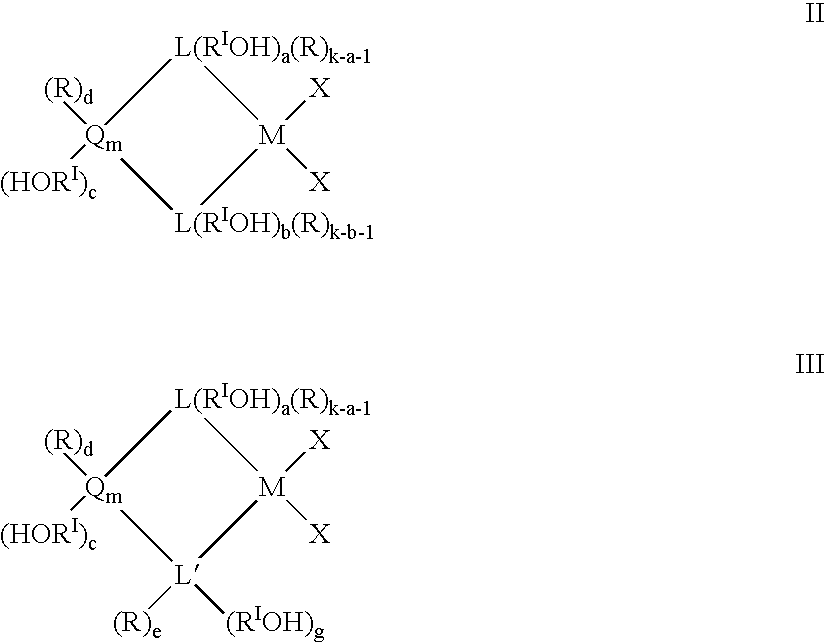Preparation and use of heterogeneous catalyst components for olefins polymerization
a technology of heterogeneous catalysts and olefins, applied in the direction of catalyst activation/preparation, organic compounds/hydrides/coordination complexes, chemical/physical processes, etc., can solve the problems of reduced industrial production and present homogeneous catalytic systems
- Summary
- Abstract
- Description
- Claims
- Application Information
AI Technical Summary
Benefits of technology
Problems solved by technology
Method used
Image
Examples
example 1
Synthesis of (cyclopentadienyl)((2-hydroxy-ethyl)-cyclopentadienyl) Zirconium Dichloride
[0686] a) Preparation of 1-trimethylsiloxy 2-bromo-ethane
[0687] To 125 g (888 mmol) of 2-bromo-ethanol, 95 ml (1450 mmol) of hexamethyldisilazane are slowly added at 0.degree. C. Ammonia evolution is immediately observed. The reaction is maintained under stirring for 12 hours and a colorless oil is obtained. (168.8 g, 856 mmol. Yield: 96%) .sup.1H-NMR (CDCl3): 3.66 (t, 2H), 3.40 (t, 2H), 0.14 (s, 9H).
[0688] b) Preparation of (2-trimethylsiloxy-ethyl)-cyclopentadiene
[0689] 150 ml of a 2.3 M sodium cyclopentadienylide solution in tetrahydrofurane (346 mmol) is slowly added to a solution of 68.2 g (346 mmol) 2-trimethylsiloxy-1-bromo-ethane in tetrahydrofurane. The immediate formation of a pinkish solid is observed. The reaction is maintained under stirring for 12 hours. Then, an ammonium chloride aqueous solution is added. The organic phase is extracted, dried with magnesium sulphate and the volati...
example 2
Synthesis of (cyclopentadienyl)((3-hydroxy-propyl)-cyclopentadienyl) Zirconium Dichloride
[0698] a) Preparation of 1-trimethylsiloxy-3-bromo-propane
[0699] To 12.2 g (76 mmol) of hexamethyldisilazane, 21 g (151 mmol) of 3-bromo-1-propanol is added. Ammonia evolution is immediately observed. The reaction is maintained under stirring for 2 hours and 24.5 g (148 mmol) of the desired compound is finally obtained. Yield: 98%. .sup.1H-NMR (CDCl3): 3.74 (t, 2H), 3.55 (t, 2H), 2.09 (m, 2H), 0.14 (s, 9H).
[0700] b) Preparation of (3-trimethylsiloxy-propyl)-cyclopentadiene
[0701] To 50 ml of a 2.3 M solution of sodium cyclopentadienylide (115 mmol), a solution of 24.3 g (115 mmol) of 3-trimethylsiloxy-1-bromo-propa-ne in tetrahydrofurane is added. The quick formation of a pinkish solid is observed. The reaction is maintained under stirring for 12 hours and then it is neutralized with an ammonium chloride solution; the organic phase is extracted and concentrated to dryness in order to give an oran...
example 3
Heterogenization of (cyclopentadienyl)((3-hydroxy-propyl)-cyclopentadienyl-) Zirconium Dichloride on Silica Functionalized with MAO
[0709] 5 g of silica Witco WMSPQ functionalized with MAO with 24% of Aluminium were weighed in a 250 ml Schlenk. The solid was suspended in 100 ml of dry toluene.
[0710] 0.11 g (0.31 mmol) of the zirconium compound were added to the above described suspension. The addition was realized at room temperature and the reaction mixture was maintained under continuous stirring. From the beginning of the reaction the solution acquired a yellow color and no changes were observed during the following two hours.
[0711] At the end of the reaction the yellow suspension was transferred to a filtering plate and it was washed with about 500 ml of toluene at room temperature. The obtained dusty cream product was then dried under vacuum for 24 hours.
[0712] The aluminium and zirconium content in the sample determined by X rays fluorescence was: 0.49% of Zr and 22.1% of Al.
PUM
| Property | Measurement | Unit |
|---|---|---|
| temperature | aaaaa | aaaaa |
| temperature | aaaaa | aaaaa |
| temperature | aaaaa | aaaaa |
Abstract
Description
Claims
Application Information
 Login to View More
Login to View More - R&D
- Intellectual Property
- Life Sciences
- Materials
- Tech Scout
- Unparalleled Data Quality
- Higher Quality Content
- 60% Fewer Hallucinations
Browse by: Latest US Patents, China's latest patents, Technical Efficacy Thesaurus, Application Domain, Technology Topic, Popular Technical Reports.
© 2025 PatSnap. All rights reserved.Legal|Privacy policy|Modern Slavery Act Transparency Statement|Sitemap|About US| Contact US: help@patsnap.com



